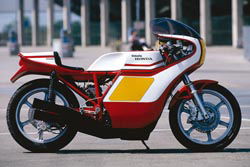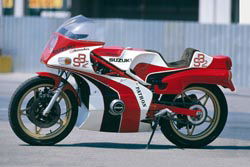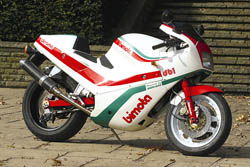The Six Sexiest Bimotas
Their business history may be erratic and their electronics legendarily so, but the one thing Bimota have always been able to do is bolt together a damn fine-looking motorcycle. Here’s the six sexiest bikes they ever built.

height=10> | |






Will the new DB7 succeed in leading Bimota to the promised land of stability and financial security? Current boss Roberto Comini clearly believes so, and seems to be doing remarkably well. But you’d have to be a real optimist to invest in a company whose history is turbulent even by the shaky standards of the Italian bike industry. Even now the UK situation is grim. The last importer, Hoss Elm of Moto Cinelli, sold just two bikes in this country over a 12-month period. Confidence in the marque has dropped to an all-time low, and there weren’t enough people prepared to pay big money for Bimota’s relatively low-powered aircooled V-twins. The brand that was once a byword for Italian performance and exclusivity has lost nearly all of its allure and credibility. And this is somewhat sad. Bimota always were a class apart, though, due initially to the brilliance of co-founder Massimo Tamburini (whose surname, along with those of his friends Valerio Bianchi and Giuseppe Morri, gave the firm its name). Bimota was founded to make air conditioning systems but moved into Grand Prix bike racing in the early ’70s, building the frames that took Johnny Cecotto, Walter Villa and Jon Ekerold to 250 and 350cc world titles. Racing has provided some of Bimota’s highs over the years. Their biggest success was the Formula One world championship won in 1987 by Virginio Ferrari aboard the FZ750-engined YB4. In 2000, Australian Anthony Gobert won a World Superbike round at Phillip Island on a TL1000-engined SB8K. But by then Bimota was deep in another of the financial holes into which it has stumbled throughout its history. This time it was the 500 Vdue, powered by Bimota’s revolutionary “clean-burning” direct-injection two-stroke engine. The V-twin refused to run properly, had to be recalled and bankrupted the entire company. By 2003, when Roberto Comini became involved, the Rimini factory had endured two lengthy periods of closure. There was a strong possibility that Bimota had disappeared for good, which makes the subsequent revival quite amazing. It now seems that there will be more Bimotas in the near future. But in case that doesn’t happen as planned, here’s the very best that they ever made. HB1YEAR: 1973 / VALUE: £28,000 / POWER: 68BHP / TOP SPEED: 133MPH The first ever Bimota was conceived at Misano in unfortunate circumstances. Massimo Tamburini crashed his CB750 at his local track in 1972, breaking three ribs and wrecking the Honda. Around its four-cylinder engine he built the HB1, featuring twin-shock steel frame, cast wheels and drilled twin front discs. With clip-ons, rearsets, full fairing, single seat and no lights, it was basically a racebike. Not that this would have deterred Tamburini, whose previous roadster had been MV Agusta’s 600 tourer, converted into a sports bike with factory engine parts and chain-drive conversion... The HB1’s chassis was much lighter and far stronger than that of the standard CB750, and the bike was due to be raced in the Imola 200. But after Tamburini and Giuseppe Morri had worked all night to prepare it, rider Luigi Anelli chose to ride another bike instead. The irate duo vowed to keep building bikes until they’d won a big race. Only a further nine examples of the HB1 were ever built, which makes this one of the rarest and most valuable Bimotas. If you ever find one and want to buy it, expect it to cost more than a new DB7. KB1YEAR: 1978 / VALUE: £11,000 / POWER: 84BHP / TOP SPEED: 148MPH Bimota’s first Kawasaki-engined four, designed in the late ’70s around the Big K’s mighty 903cc dohc Z1 powerplant, was a beautifully engineered creation that incorporated several Tamburini signature features. Its rigid chrome-moly space frame didn’t have the SB2’s conical couplings, but shared its variable steering geometry, achieved via eccentric steering head bearings (as later used by the 916). The KB1 also had a cantilever swing-arm that worked a De Carbon monoshock unit. The KB1 was a big early hit for Bimota, with more than 700 built, though most of these were constructed from frame kits rather than assembled at Rimini. Relatively few found their way over here, partly due to competition from alternatives by Brit firms including Harris and Peckett & McNab. KB1s rarely come onto the market, and they still ain’t cheap: £10,000 plus for a good one, and half that for a bike in need of attention. Production continued into the ’80s, by which time the KB1 had been joined by a similarly gorgeous KB2, powered by Kawasaki’s 500 or 550cc four-pot engine. The KB2’s trellis frame comprised no fewer than 44 steel tubes. Like several early Bims it mounted the swing-arm pivot concentric with the drive sprocket to maintain chain tension as the rear wheel moved. SB2YEAR: 1977 / VALUE: £12,000 / POWER: 69BHP / TOP SPEED: 135MPH Tamburini described the prototype SB2, which had its exhaust above the engine and fuel tank below, as the worst bike he ever designed, because it was too complicated. The production SB2, on the other hand, was possibly not just his best ever — ahead even of the Ducati 916 and MV F4 750 — but arguably the most advanced superbike ever created. Suzuki’s GS750 was itself a superb machine on its launch in 1977. How good does that make the SB2, which housed the GS’s four-pot engine in a rigid chrome-moly tubular frame that unbolted at conical couplings to aid engine removal, and was one of the first streetbikes with monoshock rear suspension? The Bimota also featured adjustable steering geometry, billet aluminium yokes and footrest brackets, magnesium wheels, twin Brembo discs, a swoopy full fairing and self-supporting aluminium tank/seat unit. The SB2 was light years ahead of everything else on the road — and it worked. Superior aerodynamics meant its top speed far exceeded that of the stock GS, especially with an 850cc Yoshi kit fitted. At 198kg it was 30kg lighter, and handled far better. At almost four grand in 1977 it was three times as expensive as the GS. Fewer than 70 were built, so it’s no surprise that they’re worth over £12,000 now. SB6YEAR: 1996 / VALUE: £6,500 / POWER: 154BHP / TOP SPEED: 156MPH Pierluigi Marconi was the talented Bologna University engineering student who came to Bimota to work on his thesis (“tesi” in Italian) of a radical, forkless motorcycle chassis, and was later hired as the firm’s chief engineer to put it into production. Marconi’s Tesi 1D was a disaster that almost bankrupted Bimota. But his SB6, powered by Suzuki’s GSX-R1100 engine, became the marque’s most successful model, with more than 1,700 sales including the later SB6R. Describing the SB6 as conventional is unfair. Its vast aluminium frame spars curved from the steering head all the way down outside the engine to incorporate the swing-arm pivots. Rear suspension was via an Öhlins unit placed horizontally on the right. Seat unit was a self-supporting carbon-fibre structure, in Grand Prix style. It blended smoothly into the tank cover, a composite of carbon and fibreglass. Beneath the bodywork was a mechanically standard, 1064cc GSX-R engine, tuned to a claimed 154bhp with Bimota’s high-level exhaust. The SB6 was better looking, 40kg lighter and much more expensive than the standard GSX-R1100. Its relatively high production means it’s now good value by Bimota standards, but you’ll still pay over £4000 for a clean one and £6500 for a minter. Surprisingly good on the track, it’s an affordable modern classic. DB1YEAR: 1985 / VALUE: £8,000 / POWER: 66BHP / TOP SPEED: 133MPH Bimota’s new chief engineer Federico Martini made his name in 1985 with the launch of the DB1, the firm’s first Ducati-powered model, which wrapped stunning, eggshell-like bodywork around a 748cc aircooled V-twin engine. Two pieces of curved glass-fibre enveloped the engine and frame, one arching over the bulbous fuel tank before coming down to act as both seat and tailpiece; the other clipping on underneath to complete a distinctive shape. Removing the bodywork required just half a dozen Dzus fasteners and a few disconnected wiring blocks. The Bimota’s Ducati-style trellis frame was neat and stiff, and held fat 42mm Marzocchi forks that featured the hydraulic reservoirs for front brake and clutch built into their tops. Damping-adjustable Marzocchi monoshock and Bimota’s own 16-inch wheels completed a hugely exotic creation. The 70bhp DB1 wasn’t particularly quick but it handled, stopped and was a success. More than 650 were sold, including the follow-up DB1-SR models. That was just as well, because the cash rescued Bimota from its first financial crisis! YB8YEAR: 1991 / VALUE: £7,000 / POWER: 164BHP / TOP SPEED: 158MPH Virginio Ferrari’s Formula One World Championship victory in 1987 aboard the Martini-designed, Yamaha FZ750 engined YB4ie didn’t just bring Bimota its most important racing success. It also sparked a string of roadsters powered by the bigger 20-valve lump from the FZR1000. The original YB6 was followed by others including the Dieci (“Ten”) and Tuatara. In 1991 came the best and fastest yet: the Furano, powered by the latest 1002cc EXUP motor, and kicking out a claimed 164bhp. Bimota’s power claims were notoriously optimistic in those days, but even so the Furano was special. It used essentially the same aluminium beam frame as the YB4, now holding multi-adjustable Öhlins kit at both ends. Marelli injection and a throaty four-into-one replaced the standard carbs and pipe. The Furano was a claimed 24bhp more powerful than the FZR1000, at 180kg it was 30kg lighter, and at £23,000 it was over three times more expensive. Few were built; only a handful came to Britain. Expect to pay £7,000 plus if you find one in good nick. According to Bimota expert Glen Wilson (www.bimota-enthusiasts.com) most owners junk the troublesome injection system for carbs. The bikes are otherwise reliable but, as with all Bimotas, damaged bodywork is a nightmare to replace. |











